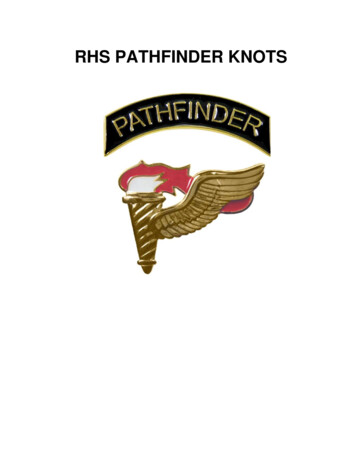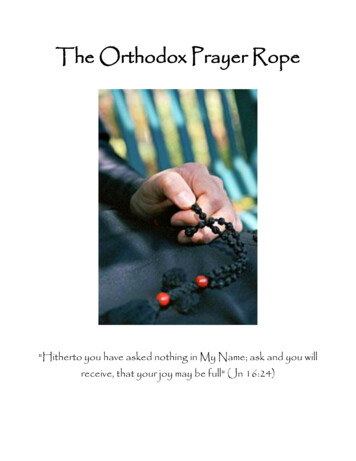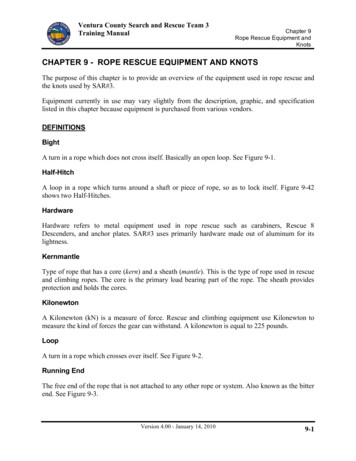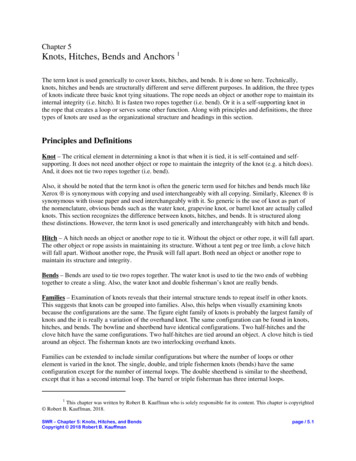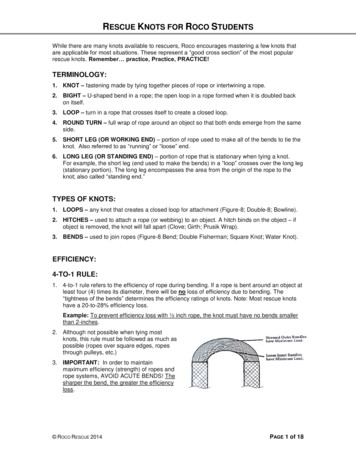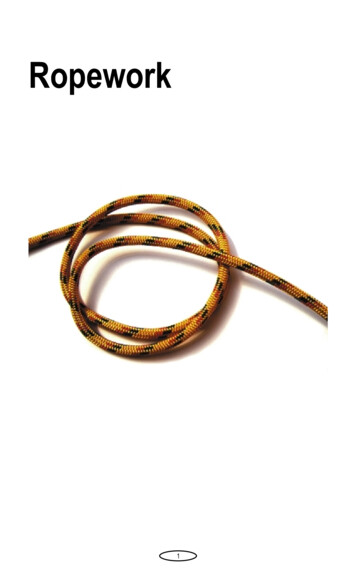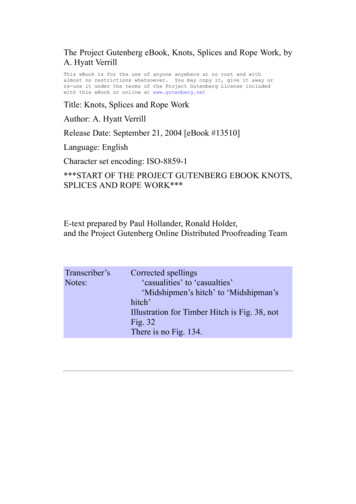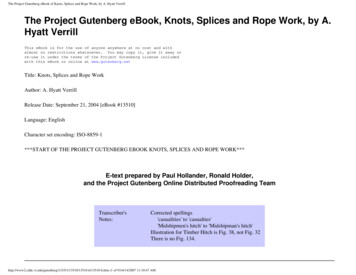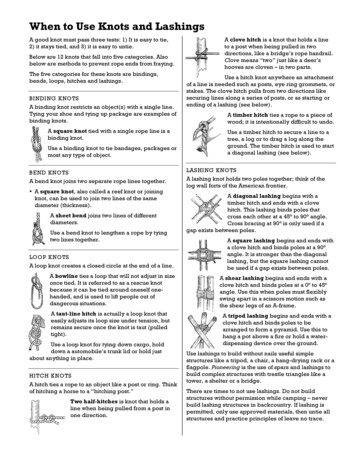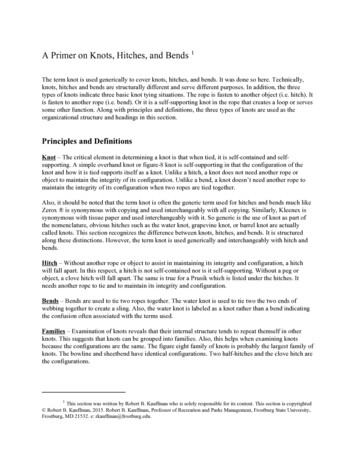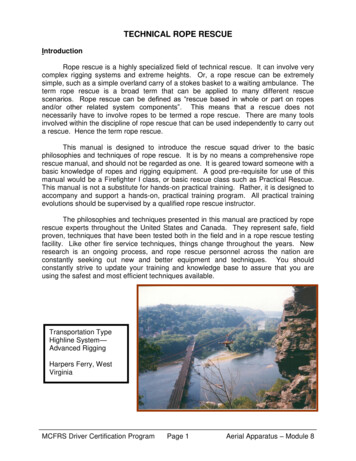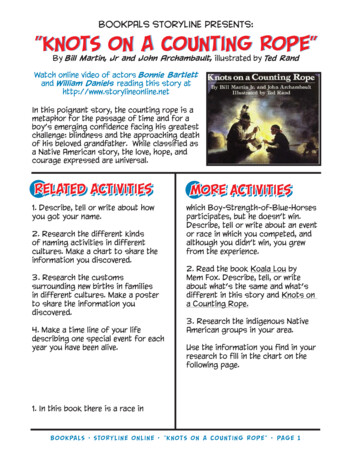
Transcription
BOOKPALS STORYLINE PRESENTS:"knots on a counting rope"By Bill Martin, Jr and John Archambault, illustrated by Ted RandWatch online video of actors Bonnie Bartlettand William Daniels reading this story athttp://www.storylineonline.netIn this poignant story, the counting rope is ametaphor for the passage of time and for aboy’s emerging confidence facing his greatestchallenge: blindness and the approaching deathof his beloved grandfather. While classified asa Native American story, the love, hope, andcourage expressed are universal.1. Describe, tell or write about howyou got your name.2. Research the different kindsof naming activities in differentcultures. Make a chart to share theinformation you discovered.3. Research the customssurrounding new births in familiesin different cultures. Make a posterto share the information youdiscovered.4. Make a time line of your lifedescribing one special event for eachyear you have been alive.which Boy-Strength-of-Blue-Horsesparticipates, but he doesn’t win.Describe, tell or write about an eventor race in which you competed, andalthough you didn’t win, you grewfrom the experience.2. Read the book Koala Lou byMem Fox. Describe, tell, or writeabout what’s the same and what’sdifferent in this story and Knots ona Counting Rope.3. Research the indigenous NativeAmerican groups in your area.Use the information you find in yourresearch to fill in the chart on thefollowing page.1. In this book there is a race inb o o k pa l s s to r y l i n e o n l i n e “ k n o t s o n a c o u n t i n g r o p e ” pa g e 1
Chart of indigenousNative American GroupsNative AmericanGroupHomesClothingFoodsb o o k pa l s s to r y l i n e o n l i n e “ k n o t s o n a c o u n t i n g r o p e ” pa g e 2
describing the subject (a thought, not acomplete sentence)continued 4. The Boy’s Grandfather was a veryimportant person in his life. Choosesomeone from your life that has madean impression on you. Describe, tell orwrite about this important person andhow they have influenced you.5. Another book about a NativeAmerican family is Annie and the OldOne by Miska Miles. Read this book andthen describe, tell or write how thesetwo Native American stories are similarand how the stories are different. Besure to include what the young boy inKnots on the Counting Rope and theyoung girl in Annie and the Old One havein common.Other books you might enjoy about thetopics in “Knots on a Counting Rope”:“Badger’s Parting Gift” by Susan Varley“Koala Lou” by Mem Fox“Nana Upstairs, Nana Downstairs”by Tomie dePaola“The Giving Tree” by Shel Silverstein“The Name Jar” by Yangsook Choi“Wind in the Willows”by Kenneth Grahame6. Describe a color in a cinquain orHaiku.A Cinquain is a form of poetry with fivelines, written using a recipe. The wordsyou choose and the form they take onpaper are an important part of the writing.Here’s the recipe:Line 1: one word to name the subjectLine 5: one word that means thesame thing as the first word, or a wordthat sums it all upHere’s an example:DogFluffy, playfulRunning, rolling, lickingA bundle of energyCanineA Haiku is a form of Japanese poetrywhich looks simple, but is really verystructured with rules for the way youwrite it. In English, Haiku consists of17 syllables, which are arranged in threelines.Here’s the recipe:Line 1: 5 syllablesLine 2: 7 syllablesLine 3: 5 syllablesHere’s an example:Spring goes, summer comesWith the warm heat from the sunSwimming, picnics fun!Now, choose a color and write aCinquain or a Haiku about the color youselected.Helpful resource books for yourwriting:“Color Dance” by Ann Jonas“Hailstones and Halibut Bones”by Mary O’Neill“My Many Color Days” by Dr. Seuss“Picasso the Green Tree Frog”by Amanda GrahamLine 2: two words to describe thesubjectLine 3: three action words about thesubjectLine 4: a four or five word phraseb o o k pa l s s to r y l i n e o n l i n e “ k n o t s o n a c o u n t i n g r o p e ” pa g e 3
Internet ActivitiesA huge part of Knots on a Counting Rope is telling how the boy got his name. Go tothese websites and read about how babies have been named throughout history.Go to .htm and read the questions and answers about the Jewish naming practices.What did you learn? Share this information with someone.Go to http://www.intersurf.com/ rcollins/names.html and read about many fascinatingfacts about the naming practices in Colonial America.What were the three most popular names for girls?What was the popular custom described that was used in Virginia and New England?Describe the ritual called “nomination” used by Quakers in Colonial Pennsylvania andDelaware.Why did the custom of Americanized names in the “Back Country” cause problems?Go to l to learn more about NativeAmerican Naming Traditions. Describe how these compare to those in the book Knots ona Counting Rope.Go to http://www.vangelis.com.au/names.asp and click on the first initial of your name.Find out information about what your name means.Bill Martin Jr. is truly one of “America’s favorite children’s authors.” He has been writingfor more than 50 years. He is the author of the classic text Brown Bear, Brown Bear,What Do You See? Bill Martin lives in the east Texas woods near Commerce, Texas. Throughthe years he has given children some of their favorite books.John Archambault is a poet, journalist and storyteller who has worked with Bill Martin Jr.for 8 years. He lives in Idyllwild, California.Other books by Bill Martin, Jr.:“Brown Bear, Brown Bear,What Do You See?”“Here Are My Hands”“Barn Dance”“Old Devil Wind”“Swish”“Little Granny Quarterback”“Polar Bear, Polar Bear,What Do You Hear?”“The Ghost-Eye Tree”Other books by John Archambault:“White Dynamite and Curly Kidd”“The Magic Pumpkin”“Grandmother’s Garden”“Words”“Chicka, Chicka, Boom, Boom”“Here Are My Hands”“Barn Dance”“Up and Down On the Merry-Go-Round”b o o k pa l s s to r y l i n e o n l i n e “ k n o t s o n a c o u n t i n g r o p e ” pa g e 4
Bonnie Bartlett grew up in Illinois and attendedNorthwestern University. She has been an actoron stage, in films and on television. She won anEmmy Award in 1986 and in 1987 for her work inthe hit series St. Elsewhere and has also appearedon television in such distinguished and popularproductions as ER, Home Improvement, Touched byan Angel, Boston Legal and Grey’s Anatomy. On film,Bonnie has been seen in such films as Promises inthe Dark, All Night Long and Dave.Bonnie met her husband, William Daniels, when theywere both attending Northwestern University. Themulti-faceted actor was born in Brooklyn and madehis first stage appearance tap dancing at the age offour and a half. Along with his sister, William performed as one-half of a song-anddance team on radio and children’s shows, and went on to work for Armed Forcesradio. Along with impressing audiences and critics with his work on theatre, film andtelevision, William won Emmy Awards in 1985 and 1986 for his work on St. Elsewhereand for seven years appeared as Mr. Feeny on the hit series Boy Meets World. Heserved as President of Screen Actors Guild from 1999-2001. William and Bonniehave two sons and four grandchildren.“Knots on a Counting Rope” published by Owlet, 1997Content developed by JAN POWELL, teacher at Seeds Elementary School, UCLA,and ELLEN NATHAN, BookPALS National Program Director.Storyline is brought to you by the Screen Actors Guild Foundation.Learn more about the BookPALS program at http://www.storylineonline.netb o o k pa l s s to r y l i n e o n l i n e “ k n o t s o n a c o u n t i n g r o p e ” pa g e 5
bookpals storyline online “knots on a counting rope” page 1 "knots on a counting rope" In this poignant story, the counting rope is a metaphor for the passage of time and for a . boy’s emerging confidence facing his greatest challenge: blindness and the approach
